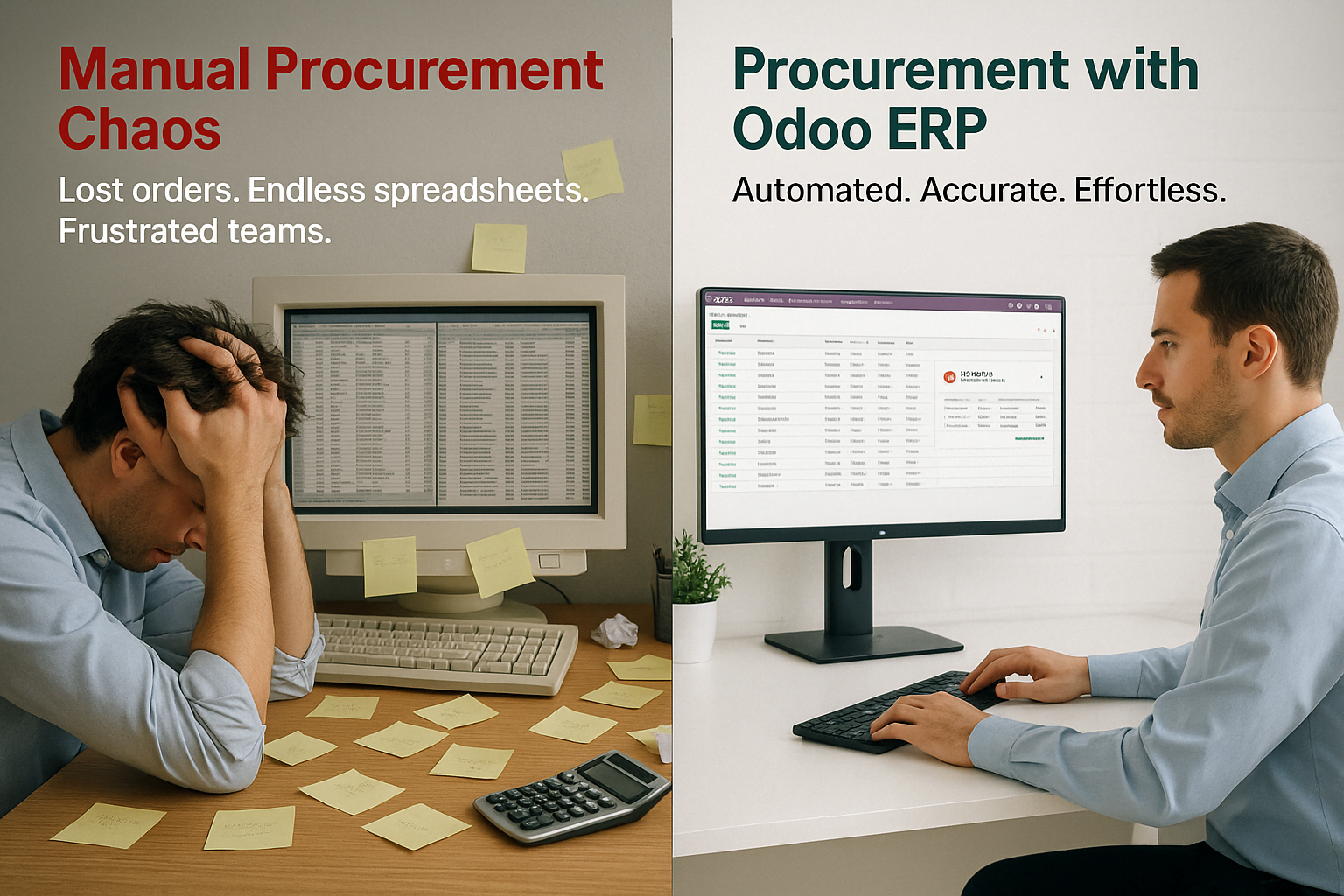91
Why Manufacturers in the UAE Struggle with Procurement and How Odoo Solves It?
04 Aug, 2025
5 min read
91
04 Aug, 2025
5 min read
Table of Content

It’s 7 AM on a Tuesday in Dubai, and your production manager walks in with a familiar look of frustration. “We’re out of critical components again,” they say. “The supplier claims they never got our order, but I know we sent it last week.” If you’re in manufacturing, this probably hits close to home.
Procurement bottlenecks, missing orders, and endless back-and-forth with suppliers are more than just daily headaches—they’re problems that stall production and eat into profitability.
According to Deloitte’s 2024 Manufacturing Outlook, 73% of manufacturers still depend on manual processes for key supply chain operations. This reliance drives operational costs up by an average of 23% compared to businesses that have embraced digital integration.
When we first meet manufacturers struggling with procurement challenges, the conversation often starts with the same concerns. The Supply Chain Manager might say, “We’re using three different spreadsheets to track our orders, and somehow things still fall through the cracks.”
Here’s what typically happens in these fragmented systems:
When we first sit down with manufacturing leaders facing these challenges, we often ask: “How many different tools or systems does your team currently use to manage procurement? Are your purchasing decisions based on real-time data or educated guesses?” The answers usually reveal the true scope of the problem.
At BiztechCS, we’ve seen how manufacturers using disconnected procurement systems spend 40% more time on administrative tasks and experience 60% more supply chain disruptions than those with integrated solutions. This is where we step in to bridge that gap.
The real tragedy isn’t just the immediate costs—it’s the missed opportunities. As you scramble to find missing components, your competitors with streamlined Odoo procurement management for manufacturers are capturing market share and building stronger customer relationships.
Imagine walking into your procurement department and seeing every purchase order, supplier communication, and delivery status displayed on a single, real-time dashboard. This isn’t a distant dream—it’s what happens when you implement automated procurement with Odoo.
When BiztechCS helps manufacturers transition to centralized procurement, we follow a proven methodology that unfolds like this:
BiztechCS begins by configuring the Odoo purchase module for manufacturers to match your specific procurement workflows. We carefully migrate your existing supplier data, pricing agreements, and purchase histories into the new system, ensuring nothing is lost in the transition.
Here’s where BiztechCS delivers real transformation. We set up automated purchase order generation based on your minimum stock levels, production schedules, and supplier lead times. No more manual tracking or forgotten reorders.
BiztechCS ensures your procurement team masters the new system through hands-on training sessions designed around their daily tasks, making the transition smooth and confidence-building.
Consider this scenario: Your production team needs 500 units of a critical component by next Tuesday. In the old system, this would trigger a chain of phone calls, email searches, and manual calculations. With Odoo’s centralized procurement:
During our initial assessments, we often ask manufacturing teams a simple question: “When was the last time a supplier delivery arrived exactly when you expected it? How much time does your team spend chasing order statuses?” The responses typically reveal hours of wasted effort daily.
This is precisely why BiztechCS recommends starting with your top 20% of suppliers (who typically represent 80% of your procurement volume) when implementing the Odoo purchase module. This approach delivers immediate impact while allowing your team to adapt gradually, ensuring a smooth transition that doesn’t disrupt your operations.
According to Statista’s 2024 Manufacturing Report, companies implementing integrated procurement systems see an average 35% reduction in purchase order processing time within the first quarter.

The moment you can answer ‘How much inventory do we have?’ with absolute confidence is the moment your manufacturing operation transforms from reactive to proactive. This is what Odoo inventory management for manufacturing delivers.
When we meet with manufacturers, we frequently hear this concern: “We’ve tried inventory systems before, but they never stay accurate.” We understand this skepticism because we’ve seen it countless times. The difference with how BiztechCS implements Odoo lies in our integration approach.
Instead of treating inventory as a separate system, Odoo connects it directly to:
BiztechCS helps you establish clear location hierarchies and implement barcode scanning for accurate tracking. We ensure every component, raw material, and finished product gets a digital identity that integrates seamlessly with your operations.
BiztechCS connects your current MRP or production planning tools with Odoo’s inventory module, ensuring data flows automatically between systems without disrupting your established workflows.
BiztechCS introduces advanced features like lot tracking, expiration date management, and multi-warehouse operations based on your specific manufacturing requirements, always with an eye toward scalability.
Here’s a common scenario we encounter: A manufacturer discovers they have three different inventory counts for the same component—one in their ERP, one in Excel, and one according to the warehouse manager’s notebook. Sound familiar?
With streamlined supply chain management with Odoo implemented by BiztechCS, accuracy becomes automatic through our proven methodology:
During our consultations, we always ask: “How often do you conduct physical inventory counts? What percentage variance do you typically find between your system records and actual stock?” These questions help us understand the current state of inventory accuracy.
At BiztechCS, we’ve consistently observed that manufacturers see inventory accuracy improve from 75-80% to 95-98% within three months of implementing integrated inventory management with our proven methodology. This transformation happens because we focus on eliminating the root causes of inaccuracy, not just treating the symptoms.
According to Odoo’s 2024 Business Impact Report, companies using integrated inventory management reduce carrying costs by an average of 22% while improving stock availability by 18%.
Your suppliers are partners in your success, but are you managing these relationships with the strategic importance they deserve? Most manufacturers we encounter treat supplier management as an administrative task rather than a competitive advantage.
Traditional supplier management often looks like this:
Odoo procurement management for manufacturers transforms this approach by providing real-time insights into every aspect of supplier performance.
Imagine walking into a supplier negotiation armed with precise data:
This isn’t just data collection—it’s strategic intelligence that transforms how you build supplier relationships.
BiztechCS helps you establish comprehensive supplier profiles that go beyond basic contact information to include performance metrics, capacity data, and strategic importance ratings that align with your business objectives.
BiztechCS configures automated tracking for key metrics: delivery performance, quality scores, responsiveness, and cost trends, creating a comprehensive supplier intelligence system.
BiztechCS develops custom dashboards that provide real-time insights into supplier performance, enabling proactive relationship management that transforms vendors into strategic partners.
Consider how this plays out in practice:
Your analytics dashboard shows that Supplier A’s delivery performance has declined from 95% to 87% over the past month. Instead of waiting for a stockout, you reach out proactively to understand their challenges and adjust your procurement strategy accordingly.
When evaluating a new supplier, you have comprehensive data on how similar suppliers have performed, enabling more informed decisions about onboarding and risk management.
In our strategic consultations, we always probe deeper: “How do you currently measure supplier performance? Are your supplier relationships based on historical assumptions or current data?” The answers reveal opportunities for transformation that many manufacturers haven’t considered.
BiztechCS has developed a comprehensive approach to supplier relationship management that balances hard metrics (delivery, quality, cost) with soft factors (communication, flexibility, innovation support). This holistic methodology strengthens partnerships while maintaining accountability, creating win-win scenarios that drive long-term success.

The results speak for themselves. According to PwC’s 2024 Digital Manufacturing Survey, manufacturers implementing integrated procurement and supply chain systems report:
But beyond the numbers, there’s a qualitative transformation that’s equally important. Manufacturing leaders tell us about sleeping better at night, knowing their supply chain is visible and predictable. Production managers report focusing on optimization rather than firefighting. Procurement teams describe moving from administrative processing to strategic sourcing.
Here’s what often surprises manufacturers: the benefits compound over time. Month 1 might deliver basic visibility and reduced manual work. Month 6 brings predictive insights and proactive decision-making. Month 12 often reveals strategic advantages they never anticipated—like the ability to respond quickly to market opportunities or weather supply chain disruptions that cripple competitors.
When we begin our assessment process, we start with a fundamental question: “If you could eliminate just one procurement-related headache from your daily operations, what would it be? How much time and stress would that save your team?” This question often unlocks the core issues that need immediate attention.
The journey to streamlined supply chain management with Odoo doesn’t require a complete operational overhaul overnight. Here’s how successful UAE manufacturers typically approach the transformation:
At BiztechCS, we’ve learned that manufacturers who take a phased approach achieve better user adoption and see measurable improvements at each stage, building momentum for the complete transformation. This is why we’ve structured our methodology around progressive implementation rather than overwhelming system overhauls.

Manufacturing in the UAE is evolving rapidly, and supply chain excellence is becoming a key differentiator. The manufacturers who thrive in the coming years will be those who move beyond reactive procurement to strategic, data-driven supply chain management.
If you’re ready to explore how automated procurement with Odoo could transform your operations, we’re here to help you navigate that journey. Every manufacturer’s needs are unique, and the most effective transformations are tailored to your specific challenges, goals, and operational context.
The question isn’t whether to modernize your procurement and supply chain operations—it’s how quickly you can gain the competitive advantages that come with integrated, intelligent systems.

68
By Biztech
09 Oct, 2025

75
By Biztech
09 Oct, 2025

91
By Biztech
06 Oct, 2025